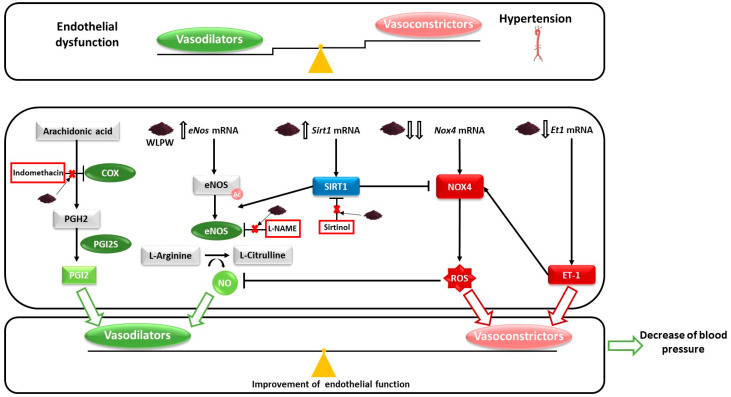Figure 6.
Schematic representation of the molecular mechanisms involved in the blood pressure (BP)-lowering effect of wine lees powder (WLPW) in endothelium. WLPW upregulates endothelial nitric oxide (eNos) mRNA levels, which would lead to higher production of nitric oxide (NO). WLPW increases plasma NO levels [15]. Sirtuin-1 (Sirt1) mRNA levels are also upregulated by WLPW. The enzyme SIRT1, which mediates partially the antihypertensive effect of WLPW, demonstrated after sirtinol administration, is able to increase eNos expression. In addition, SIRT1 deacetylates and activates eNOS and inhibits NADPH oxidase subunit 4 (NOX4). Furthermore, Nox4 mRNA levels were downregulated by WLPW. The decrease in the expression and activity of NOX4 would lead to a decrease in radical oxygen species (ROS) production and consequently, an increase in NO availability. All these events would lead to the increase of NO availability, which mediates the antihypertensive effect of WLPW, as it has been demonstrated after L-NAME administration. WLPW exerts an improvement of oxidative stress since reduces levels of hepatic ROS and plasma malondialdehyde and increases levels of hepatic reduced glutathione [15]. In addition, the indomethacin study has demonstrated that the endothelium-derived vasodilator factor prostaglandin I2 (PGI2) mediates partially the BP-lowering effect of WLPW. Moreover, WLPW also downregulates the expression of the vasoconstrictor endothelin-1 (Et1) mRNA levels, which would lead to lower production of NO. All of these factors lead to a restoration of the imbalance of endothelial-derived vasodilator and vasoconstrictor factors caused by hypertension, improving endothelial function and decreasing BP. Arrows ending in points represent activation and those ending in lines represent inhibition. Red crosses indicate that WLPW antihypertensive effect disappears totally or partially when animals are further treated indomethacin, L-NAME or sirtinol.

